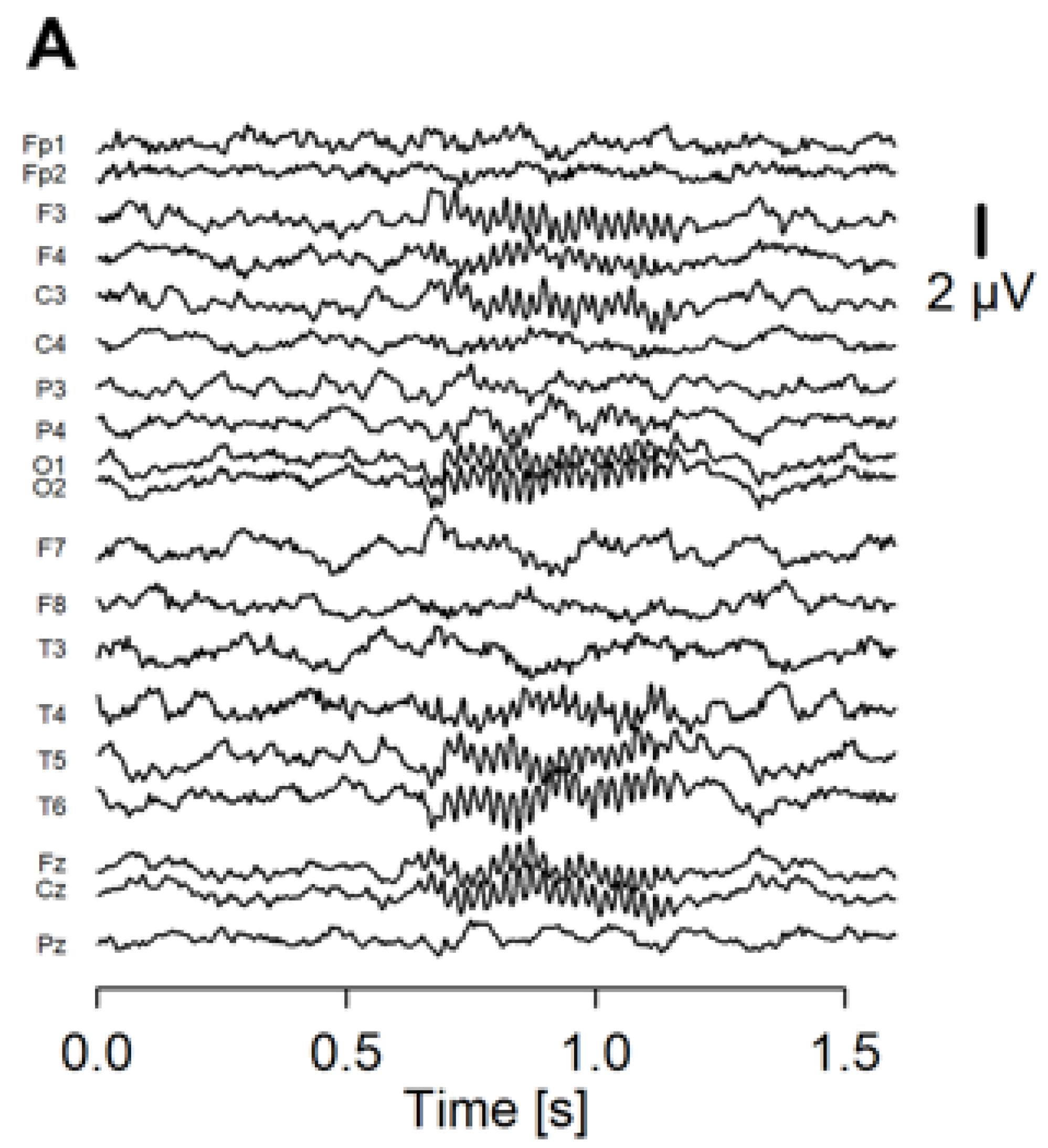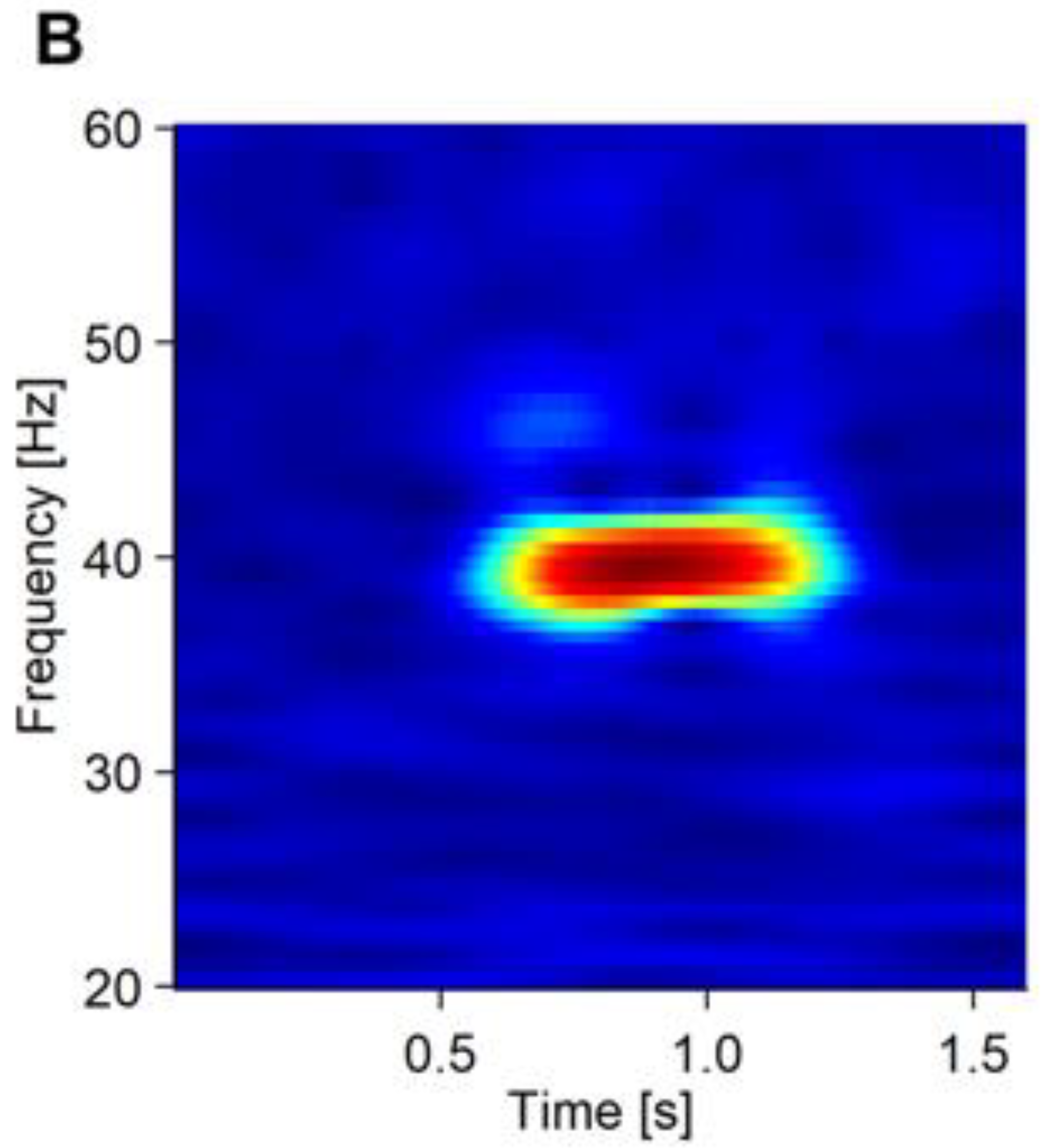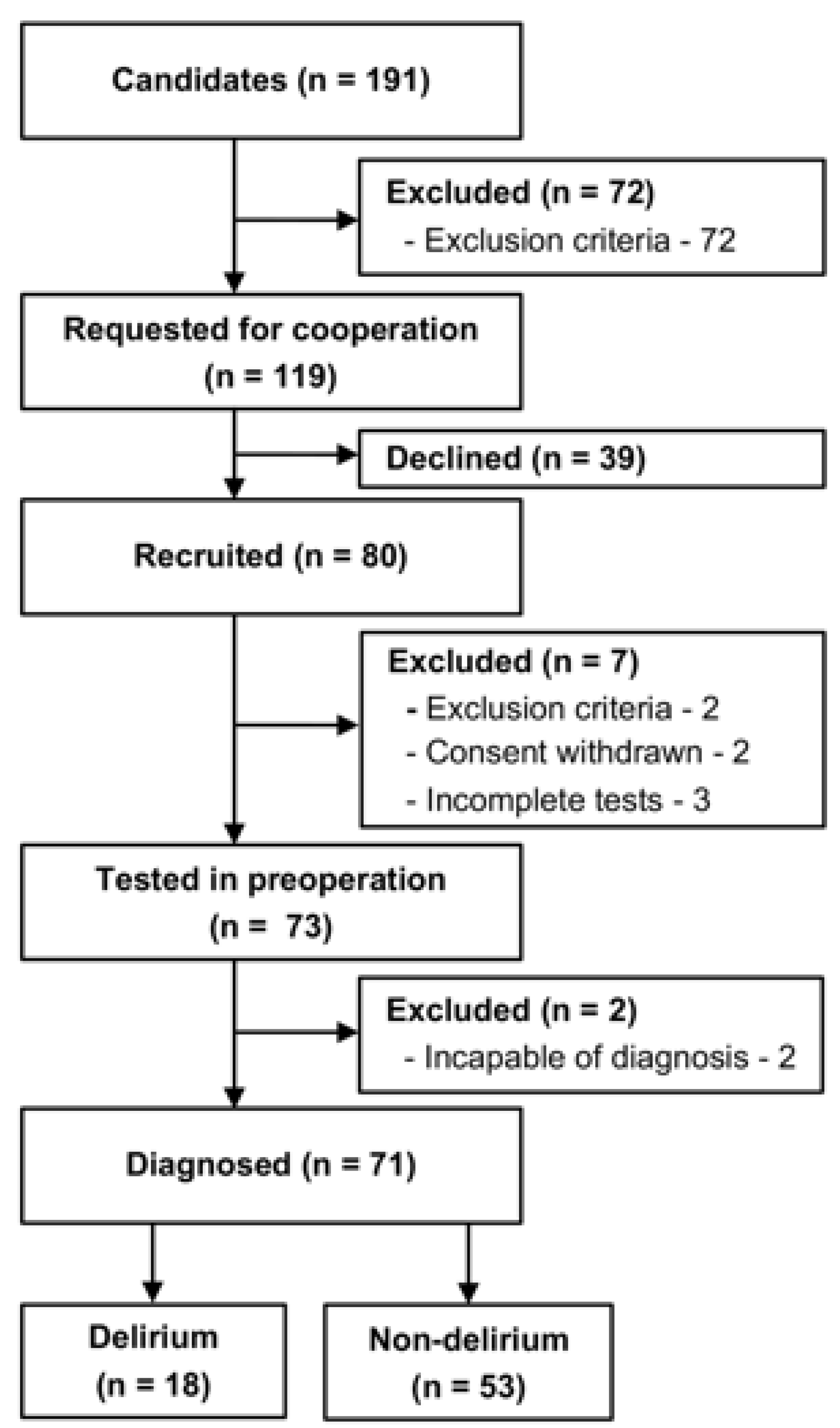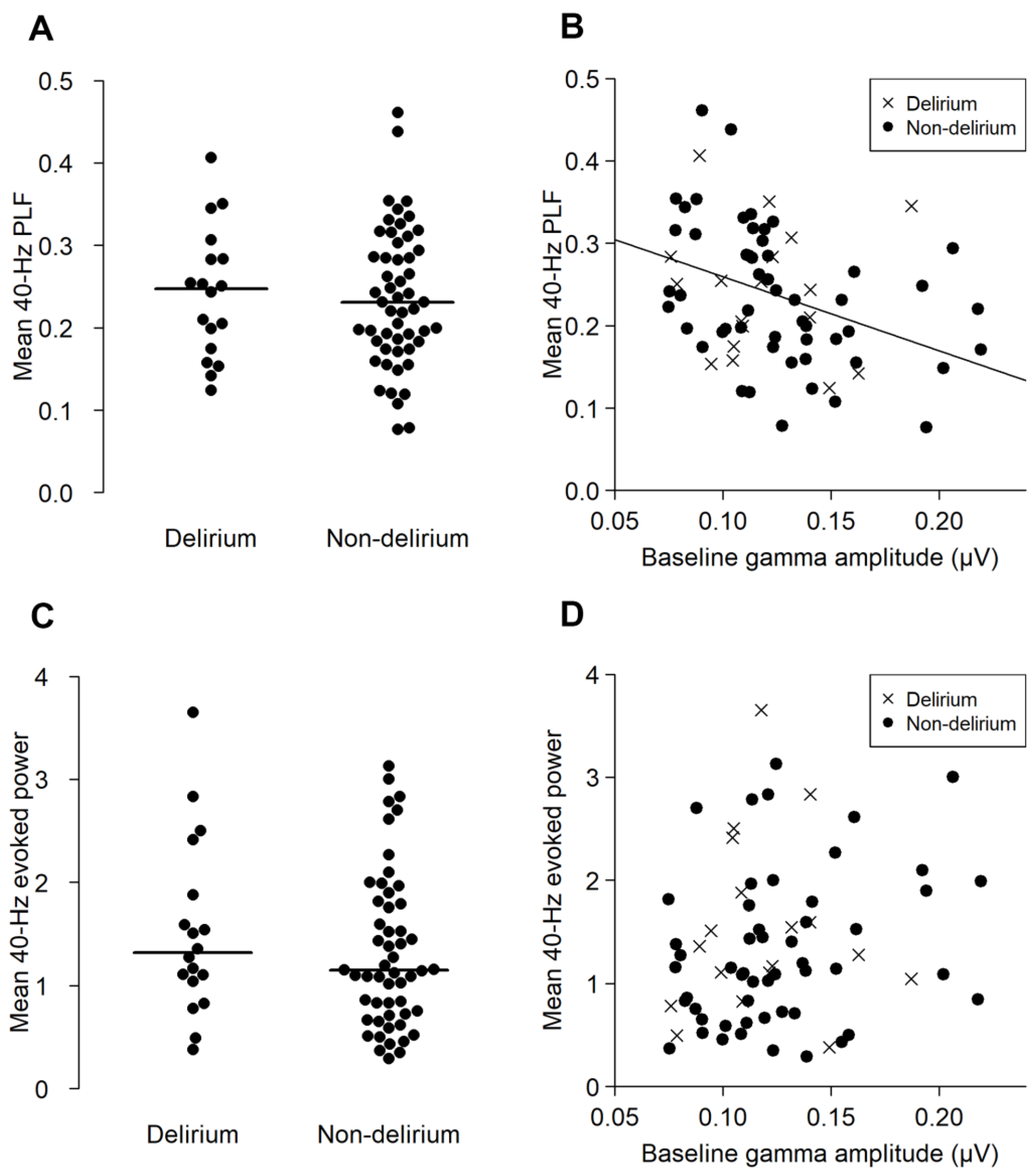The Association between Electroencephalography with Auditory Steady-State Response and Postoperative Delirium
Abstract
1. Introduction
2. Materials and Methods
2.1. Participants
2.2. EEG Recordings
2.3. EEG Analysis
2.4. Statistical Analysis
3. Results
3.1. Clinico-Demographic Data
3.2. Neurophysiological Measures with ASSR
3.3. Clinical Measures for Delirium
4. Discussion
5. Conclusions
Author Contributions
Funding
Institutional Review Board Statement
Informed Consent Statement
Data Availability Statement
Acknowledgments
Conflicts of Interest
References
- Casanova, M.F.; Shaban, M.; Ghazal, M.; El-Baz, A.S.; Casanova, E.L.; Sokhadze, E.M. Ringing Decay of Gamma Oscillations and Transcranial Magnetic Stimulation Therapy in Autism Spectrum Disorder. Appl. Psychophysiol. Biofeedback 2021, 46, 161–173. [Google Scholar] [CrossRef] [PubMed]
- Thuné, H.; Recasens, M.; Uhlhaas, P.J. The 40-Hz Auditory Steady-State Response in Patients with Schizophrenia: A Meta-Analysis. JAMA Psychiatry 2016, 73, 1145–1153. [Google Scholar] [CrossRef] [PubMed]
- Isomura, S.; Onitsuka, T.; Tsuchimoto, R.; Nakamura, I.; Hirano, S.; Oda, Y.; Oribe, N.; Hirano, Y.; Ueno, T.; Kanba, S. Differentiation between Major Depressive Disorder and Bipolar Disorder by Auditory Steady-State Responses. J. Affect. Disord. 2016, 190, 800–806. [Google Scholar] [CrossRef] [PubMed]
- Spencer, K.M. Baseline Gamma Power during Auditory Steady-State Stimulation in Schizophrenia. Front. Hum. Neurosci. 2011, 5, 190. [Google Scholar] [CrossRef] [PubMed]
- Onitsuka, T.; Tsuchimoto, R.; Oribe, N.; Spencer, K.M.; Hirano, Y. Neuronal imbalance of excitation and inhibition in schizophrenia: A scoping review of gamma-band ASSR findings. Psychiatry Clin. Neurosci. 2022, 76, 610–619. [Google Scholar] [CrossRef]
- Lipowski, Z.J. Transient Cognitive Disorders (Delirium, Acute Confusional Sates) in the Elderly. In Psychosomatic Medicine and Liaison Psychiatry; Springer: Berlin/Heidelberg, Germany, 1983; pp. 289–306. [Google Scholar]
- Wilson, J.E.; Mart, M.F.; Cunningham, C.; Shehabi, Y.; Girard, T.D.; MacLullich, A.M.J.; Slooter, A.J.C.; Ely, E.W. Delirium. Nat. Rev. Dis. Primers. 2020, 6, 90. [Google Scholar] [CrossRef]
- American Psychiatric Association. Diagnostic and Statistical Manual of Mental Disorders (DSM-5®); American Psychiatric Pub: Washington, DC, USA, 2013; ISBN 9780890425572. [Google Scholar]
- Neumarker, K.-J. Karl Bonhoeffer and the Concept of Symptomatic Psychoses. Hist. Psychiatry 2001, 12, 213–226. [Google Scholar] [CrossRef]
- WHO. The ICD-10 Classification of Mental and Behavioural Disorders: Diagnostic Criteria for Research; World Health Organization: Geneva, Switzerland, 1993; ISBN 9789241544559. [Google Scholar]
- Gibb, K.; Seeley, A.; Quinn, T.; Siddiqi, N.; Shenkin, S.; Rockwood, K.; Davis, D. The Consistent Burden in Published Estimates of Delirium Occurrence in Medical Inpatients over Four Decades: A Systematic Review and Meta-Analysis Study. Age Ageing 2020, 49, 352–360. [Google Scholar] [CrossRef]
- Witlox, J.; Eurelings, L.S.M.; de Jonghe, J.F.M.; Kalisvaart, K.J.; Eikelenboom, P.; van Gool, W.A. Delirium in Elderly Patients and the Risk of Postdischarge Mortality, Institutionalization, and Dementia: A Meta-Analysis. JAMA 2010, 304, 443–451. [Google Scholar] [CrossRef]
- Goldberg, T.E.; Chen, C.; Wang, Y.; Jung, E.; Swanson, A.; Ing, C.; Garcia, P.S.; Whittington, R.A.; Moitra, V. Association of Delirium with Long-Term Cognitive Decline: A Meta-Analysis. JAMA Neurol. 2020, 77, 1373–1381. [Google Scholar] [CrossRef]
- Dani, M.; Owen, L.H.; Jackson, T.A.; Rockwood, K.; Sampson, E.L.; Davis, D. Delirium, Frailty, and Mortality: Interactions in a Prospective Study of Hospitalized Older People. J. Gerontol. A Biol. Sci. Med. Sci. 2018, 73, 415–418. [Google Scholar] [CrossRef] [PubMed]
- Moskowitz, E.E.; Overbey, D.M.; Jones, T.S.; Jones, E.L.; Arcomano, T.R.; Moore, J.T.; Robinson, T.N. Post-Operative Delirium Is Associated with Increased 5-Year Mortality. Am. J. Surg. 2017, 214, 1036–1038. [Google Scholar] [CrossRef] [PubMed]
- Leslie, D.L.; Inouye, S.K. The Importance of Delirium: Economic and Societal Costs. J. Am. Geriatr. Soc. 2011, 59 (Suppl. S2), S241–S243. [Google Scholar] [CrossRef] [PubMed]
- Harper, G.M.; Lyons, W.L.; Potter, J.F. Geriatrics Review Syllabus: (GRS10); American Geriatrics Society: New York, NY, USA, 2021; ISBN 9781886775688. [Google Scholar]
- Marcantonio, E.R. Postoperative Delirium: A 76-Year-Old Woman with Delirium Following Surgery. JAMA 2012, 308, 73–81. [Google Scholar] [CrossRef] [PubMed]
- Hirano, Y.; Oribe, N.; Kanba, S.; Onitsuka, T.; Nestor, P.G.; Spencer, K.M. Spontaneous Gamma Activity in Schizophrenia. JAMA Psychiatry 2015, 72, 813–821. [Google Scholar] [CrossRef]
- Hirano, Y.; Uhlhaas, P.J. Current Findings and Perspectives on Aberrant Neural Oscillations in Schizophrenia. Psychiatry Clin. Neurosci. 2021, 75, 358–368. [Google Scholar] [CrossRef]
- Ono, Y.; Kudoh, K.; Ikeda, T.; Takahashi, T.; Yoshimura, Y.; Minabe, Y.; Kikuchi, M. Auditory Steady-State Response at 20 Hz and 40 Hz in Young Typically Developing Children and Children with Autism Spectrum Disorder. Psychiatry Clin. Neurosci. 2020, 74, 354–361. [Google Scholar] [CrossRef]
- Sivarao, D.V.; Chen, P.; Senapati, A.; Yang, Y.; Fernandes, A.; Benitex, Y.; Whiterock, V.; Li, Y.-W.; Ahlijanian, M.K. 40 Hz Auditory Steady-State Response Is a Pharmacodynamic Biomarker for Cortical NMDA Receptors. Neuropsychopharmacology 2016, 41, 2232–2240. [Google Scholar] [CrossRef]
- Başar, E.; Başar-Eroğlu, C.; Güntekin, B.; Yener, G.G. Chapter 2-Brain’s Alpha, Beta, Gamma, Delta, and Theta Oscillations in Neuropsychiatric Diseases: Proposal for Biomarker Strategies. In Supplements to Clinical Neurophysiology; Başar, E., Başar-Eroĝlu, C., Özerdem, A., Rossini, P.M., Yener, G.G., Eds.; Elsevier: Amsterdam, The Netherlands, 2013; Volume 62, pp. 19–54. [Google Scholar]
- Jafari, Z.; Kolb, B.E.; Mohajerani, M.H. Neural Oscillations and Brain Stimulation in Alzheimer’s Disease. Prog. Neurobiol. 2020, 194, 101878. [Google Scholar] [CrossRef]
- Palop, J.J.; Chin, J.; Roberson, E.D.; Wang, J.; Thwin, M.T.; Bien-Ly, N.; Yoo, J.; Ho, K.O.; Yu, G.-Q.; Kreitzer, A.; et al. Aberrant Excitatory Neuronal Activity and Compensatory Remodeling of Inhibitory Hippocampal Circuits in Mouse Models of Alzheimer’s Disease. Neuron 2007, 55, 697–711. [Google Scholar] [CrossRef]
- Toader, O.; von Heimendahl, M.; Schuelert, N.; Nissen, W.; Rosenbrock, H. Suppression of Parvalbumin Interneuron Activity in the Prefrontal Cortex Recapitulates Features of Impaired Excitatory/Inhibitory Balance and Sensory Processing in Schizophrenia. Schizophr. Bull. 2020, 46, 981–989. [Google Scholar] [CrossRef] [PubMed]
- Boord, M.S.; Moezzi, B.; Davis, D.; Ross, T.J.; Coussens, S.; Psaltis, P.J.; Bourke, A.; Keage, H.A.D. Investigating How Electroencephalogram Measures Associate with Delirium: A Systematic Review. Clin. Neurophysiol. 2021, 132, 246–257. [Google Scholar] [CrossRef] [PubMed]
- Tanabe, S.; Mohanty, R.; Lindroth, H.; Casey, C.; Ballweg, T.; Farahbakhsh, Z.; Krause, B.; Prabhakaran, V.; Banks, M.I.; Sanders, R.D. Cohort Study into the Neural Correlates of Postoperative Delirium: The Role of Connectivity and Slow-Wave Activity. Br. J. Anaesth. 2020, 125, 55–66. [Google Scholar] [CrossRef] [PubMed]
- Sugishita, M. F5-01-02: Adapting Scales for Use in Global Clinical Alzheimer’s Disease Trials. Alzheimer’s Dement. 2009, 5, P170. [Google Scholar] [CrossRef]
- Folstein, M.F.; Folstein, S.E.; McHugh, P.R. “Mini-Mental State”: A Practical Method for Grading the Cognitive State of Patients for the Clinician. J. Psychiatr. Res. 1975, 12, 189–198. [Google Scholar] [CrossRef]
- Afonso, A.; Scurlock, C.; Reich, D.; Raikhelkar, J.; Hossain, S.; Bodian, C.; Krol, M.; Flynn, B. Predictive Model for Postoperative Delirium in Cardiac Surgical Patients. Semin. Cardiothorac. Vasc. Anesth. 2010, 14, 212–217. [Google Scholar] [CrossRef]
- Tully, P.J.; Baker, R.A.; Winefield, H.R.; Turnbull, D.A. Depression, Anxiety Disorders and Type D Personality as Risk Factors for Delirium after Cardiac Surgery. Aust. N. Z. J. Psychiatry 2010, 44, 1005–1011. [Google Scholar]
- Sirois, F. Steroid Psychosis: A Review. Gen. Hosp. Psychiatry 2003, 25, 27–33. [Google Scholar] [CrossRef]
- Trzepacz, P.T.; Mittal, D.; Torres, R.; Kanary, K.; Norton, J.; Jimerson, N. Validation of the Delirium Rating Scale-Revised-98: Comparison with the Delirium Rating Scale and the Cognitive Test for Delirium. J. Neuropsychiatry Clin. Neurosci. 2001, 13, 229–242. [Google Scholar] [CrossRef]
- Kato, M.; Kishi, Y.; Okuyama, T.; Trzepacz, P.T.; Hosaka, T. Japanese Version of the Delirium Rating Scale, Revised–98 (DRS-R98–J): Reliability and Validity. Psychosomatics 2010, 51, 425–431. [Google Scholar]
- Breitbart, W.; Rosenfeld, B.; Roth, A.; Smith, M.J.; Cohen, K.; Passik, S. The Memorial Delirium Assessment Scale. J. Pain Symptom Manag. 1997, 13, 128–137. [Google Scholar] [CrossRef] [PubMed]
- Matsuoka, Y.; Miyake, Y.; Arakaki, H.; Tanaka, K.; Saeki, T.; Yamawaki, S. Clinical Utility and Validation of the Japanese Version of Memorial Delirium Assessment Scale in a Psychogeriatric Inpatient Setting. Gen. Hosp. Psychiatry 2001, 23, 36–40. [Google Scholar] [CrossRef] [PubMed]
- Charlson, M.; Szatrowski, T.P.; Peterson, J.; Gold, J. Validation of a Combined Comorbidity Index. J. Clin. Epidemiol. 1994, 47, 1245–1251. [Google Scholar] [CrossRef] [PubMed]
- Collin, C.; Wade, D.T.; Davies, S.; Horne, V. The Barthel ADL Index: A Reliability Study. Int. Disabil. Stud. 1988, 10, 61–63. [Google Scholar] [CrossRef]
- Liang, C.-K.; Chu, C.-L.; Chou, M.-Y.; Lin, Y.-T.; Lu, T.; Hsu, C.-J.; Chen, L.-K. Interrelationship of Postoperative Delirium and Cognitive Impairment and Their Impact on the Functional Status in Older Patients Undergoing Orthopaedic Surgery: A Prospective Cohort Study. PLoS ONE 2014, 9, e110339. [Google Scholar] [CrossRef]
- Tan, M.C.; Felde, A.; Kuskowski, M.; Ward, H.; Kelly, R.F.; Adabag, A.S.; Dysken, M. Incidence and Predictors of Post-Cardiotomy Delirium. Am. J. Geriatr. Psychiatry 2008, 16, 575–583. [Google Scholar] [CrossRef]
- Hsieh, S.J.; Shum, M.; Lee, A.N.; Hasselmark, F.; Gong, M.N. Cigarette Smoking as a Risk Factor for Delirium in Hospitalized and Intensive Care Unit Patients. A Systematic Review. Ann. Am. Thorac. Soc. 2013, 10, 496–503. [Google Scholar] [CrossRef] [PubMed]
- Janssen, T.L.; Alberts, A.R.; Hooft, L.; Mattace-Raso, F.; Mosk, C.A.; van der Laan, L. Prevention of Postoperative Delirium in Elderly Patients Planned for Elective Surgery: Systematic Review and Meta-Analysis. Clin. Interv. Aging 2019, 14, 1095–1117. [Google Scholar] [CrossRef]
- Skosnik, P.D.; Krishnan, G.P.; O’Donnell, B.F. The Effect of Selective Attention on the Gamma-Band Auditory Steady-State Response. Neurosci. Lett. 2007, 420, 223–228. [Google Scholar] [CrossRef]
- Tallon-Baudry, C.; Bertrand, O.; Delpuech, C.; Pernier, J. Oscillatory γ-Band (30–70 Hz) Activity Induced by a Visual Search Task in Humans. J. Neurosci. 1997, 17, 722–734. [Google Scholar] [CrossRef]
- Wiegand, T.L.T.; Rémi, J.; Dimitriadis, K. Electroencephalography in Delirium Assessment: A Scoping Review. BMC Neurol. 2022, 22, 86. [Google Scholar] [CrossRef] [PubMed]
- Ben-Ari, Y. Seizures Beget Seizures: The Quest for GABA as a Key Player. Crit. Rev. Neurobiol. 2006, 18, 135–144. [Google Scholar] [CrossRef] [PubMed]
- Bartolomei, F. Coherent Neural Activity and Brain Synchronization during Seizure-Induced Loss of Consciousness. Arch. Ital. Biol. 2012, 150, 164–171. [Google Scholar] [PubMed]
- Lapitskaya, N.; Gosseries, O.; De Pasqua, V.; Pedersen, A.R.; Nielsen, J.F.; de Noordhout, A.M.; Laureys, S. Abnormal Corticospinal Excitability in Patients with Disorders of Consciousness. Brain Stimul. 2013, 6, 590–597. [Google Scholar] [CrossRef] [PubMed]
- Sanders, R.D. Hypothesis for the Pathophysiology of Delirium: Role of Baseline Brain Network Connectivity and Changes in Inhibitory Tone. Med. Hypotheses 2011, 77, 140–143. [Google Scholar] [CrossRef]
- Maldonado, J.R. Delirium Pathophysiology: An Updated Hypothesis of the Etiology of Acute Brain Failure. Int. J. Geriatr. Psychiatry 2018, 33, 1428–1457. [Google Scholar] [CrossRef]
- Seymour, R.A.; Rippon, G.; Gooding-Williams, G.; Sowman, P.F.; Kessler, K. Reduced Auditory Steady State Responses in Autism Spectrum Disorder. Mol. Autism 2020, 11, 56. [Google Scholar] [CrossRef]
- Koshiyama, D.; Miyakoshi, M.; Joshi, Y.B.; Molina, J.L.; Tanaka-Koshiyama, K.; Sprock, J.; Braff, D.L.; Swerdlow, N.R.; Light, G.A. A Distributed Frontotemporal Network Underlies Gamma-Band Synchronization Impairments in Schizophrenia Patients. Neuropsychopharmacology 2020, 45, 2198–2206. [Google Scholar] [CrossRef]
- Tada, M.; Nagai, T.; Kirihara, K.; Koike, S.; Suga, M.; Araki, T.; Kobayashi, T.; Kasai, K. Differential Alterations of Auditory Gamma Oscillatory Responses between Pre-Onset High-Risk Individuals and First-Episode Schizophrenia. Cereb. Cortex 2016, 26, 1027–1035. [Google Scholar] [CrossRef]
- Leicht, G.; Vauth, S.; Polomac, N.; Andreou, C.; Rauh, J.; Mußmann, M.; Karow, A.; Mulert, C. EEG-Informed FMRI Reveals a Disturbed Gamma-Band-Specific Network in Subjects at High Risk for Psychosis. Schizophr. Bull. 2016, 42, 239–249. [Google Scholar] [CrossRef]
- Koshiyama, D.; Kirihara, K.; Tada, M.; Nagai, T.; Fujioka, M.; Ichikawa, E.; Ohta, K.; Tani, M.; Tsuchiya, M.; Kanehara, A.; et al. Electrophysiological Evidence for Abnormal Glutamate-GABA Association Following Psychosis Onset. Transl. Psychiatry 2018, 8, 211. [Google Scholar] [CrossRef] [PubMed]
- Lepock, E.; Mizrahi, A.S. Relationships between Cognitive Event-Related Brain Potential Measures in Patients at Clinical High Risk for Psychosis. Schizophr. Res. 2020, 226, 84–94. [Google Scholar] [CrossRef] [PubMed]
- Dittrich, T.; Marsch, S.; Rüegg, S.; De Marchis, G.M.; Tschudin-Sutter, S.; Sutter, R. Delirium in Meningitis and Encephalitis: Emergence and Prediction in a 6-Year Cohort. J. Intensive Care Med. 2021, 36, 566–575. [Google Scholar] [CrossRef] [PubMed]
- Stojanovich, L.; Zandman-Goddard, G.; Pavlovich, S.; Sikanich, N. Psychiatric Manifestations in Systemic Lupus Erythematosus. Autoimmun. Rev. 2007, 6, 421–426. [Google Scholar] [CrossRef] [PubMed]
- Ellul, M.; Solomon, T. Acute Encephalitis—Diagnosis and Management. Clin. Med. 2018, 18, 155–159. [Google Scholar] [CrossRef] [PubMed]
- Wang, X.; Li, Y.; Li, Z.; Li, J.; Xu, J.; Yang, P.; Qin, L. Neuroprotective Effect of Microglia against Impairments of Auditory Steady-State Response Induced by Anti-P IgG from SLE Patients in Naïve Mice. J. Neuroinflammation 2020, 17, 31. [Google Scholar] [CrossRef]
- Fels, E.; Mayeur, M.-E.; Wayere, E.; Vincent, C.; Malleval, C.; Honnorat, J.; Pascual, O. Dysregulation of the Hippocampal Neuronal Network by LGI1 Auto-Antibodies. PLoS ONE 2022, 17, e0272277. [Google Scholar] [CrossRef]
- Jones, R.N.; Yang, F.M.; Zhang, Y.; Kiely, D.K.; Marcantonio, E.R.; Inouye, S.K. Does Educational Attainment Contribute to Risk for Delirium? A Potential Role for Cognitive Reserve. J. Gerontol. A Biol. Sci. Med. Sci. 2006, 61, 1307–1311. [Google Scholar] [CrossRef]
- Feinkohl, I.; Winterer, G.; Spies, C.D.; Pischon, T. Cognitive Reserve and the Risk of Postoperative Cognitive Dysfunction. Dtsch. Arztebl. Int. 2017, 114, 110–117. [Google Scholar] [CrossRef]
- Cole, M.G.; Ciampi, A.; Belzile, E.; Dubuc-Sarrasin, M. Subsyndromal Delirium in Older People: A Systematic Review of Frequency, Risk Factors, Course and Outcomes. Int. J. Geriatr. Psychiatry 2013, 28, 771–780. [Google Scholar] [CrossRef]
- Jin, Z.; Hu, J.; Ma, D. Postoperative Delirium: Perioperative Assessment, Risk Reduction, and Management. Br. J. Anaesth. 2020, 125, 492–504. [Google Scholar] [CrossRef] [PubMed]
- European Delirium Association; American Delirium Society. The DSM-5 Criteria, Level of Arousal and Delirium Diagnosis: Inclusiveness Is Safer. BMC Med. 2014, 12, 141. [Google Scholar]




| Delirium (n = 18) | Non-Delirium (n = 53) | p | |
|---|---|---|---|
| Sex, Female (%) | 5 (27.8) | 16 (30.2) | 1.000 |
| Age (mean ± SD, years) | 76.6 ± 4.7 | 72.3 ± 9.9 | 0.154 |
| Body Mass Index (mean ± SD) | 22.0 ± 2.6 | 23.3 ± 3.2 | 0.467 |
| Educational year (mean ± SD, years) | 13.1 ± 3.1 | 15.2 ± 2.5 | 0.029 |
| Surgical site, Thoracic surgery (%) | 17 (94.4) | 42 (79.2) | 0.262 |
| Past history of delirium (%) | 4 (22.2) | 2 (3.78) | 0.052 |
| Active smoker (%) | 3 (16.7) | 3 (5.6) | 0.337 |
| Alcohol in 2 weeks (%) | 9 (50) | 27 (51) | 1.000 |
| Hemoglobin (mean ± SD, mg/dL) a | 12.0 ± 2.6 | 12.9 ± 1.2 | 0.101 |
| C-reactive protein (mean ± SD, mg/dL) a | 0.29 ± 0.38 | 0.23 ± 0.49 | 0.079 |
| Albumin (mean ± SD, g/dL) a | 3.8 ± 0.4 | 4.0 ± 0.4 | 0.085 |
| Delirium | Delirium | Non-Delirium | p |
|---|---|---|---|
| Pre MMSE | 27.8 ± 1.6 | 28.2 ± 1.5 | 0.373 |
| Charlson Comorbidity Index | 1.3 ± 1.6 | 1.2 ± 1.4 | 0.961 |
| Barthel index | 99.4 ± 2.4 | 100 ± 0.0 | 0.092 |
| Post DRS-R98 | 15.6 ± 2.76 | 4.2 ± 2.82 | <0.01 |
| Post MDAS | 9.6 ± 1.26 | 2.6 ± 1.79 | <0.01 |
Disclaimer/Publisher’s Note: The statements, opinions and data contained in all publications are solely those of the individual author(s) and contributor(s) and not of MDPI and/or the editor(s). MDPI and/or the editor(s) disclaim responsibility for any injury to people or property resulting from any ideas, methods, instructions or products referred to in the content. |
© 2022 by the authors. Licensee MDPI, Basel, Switzerland. This article is an open access article distributed under the terms and conditions of the Creative Commons Attribution (CC BY) license (https://creativecommons.org/licenses/by/4.0/).
Share and Cite
Arai, N.; Miyazaki, T.; Nakajima, S.; Okamoto, S.; Moriyama, S.; Niinomi, K.; Takayama, K.; Kato, J.; Nakamura, I.; Hirano, Y.; et al. The Association between Electroencephalography with Auditory Steady-State Response and Postoperative Delirium. J. Pers. Med. 2023, 13, 35. https://doi.org/10.3390/jpm13010035
Arai N, Miyazaki T, Nakajima S, Okamoto S, Moriyama S, Niinomi K, Takayama K, Kato J, Nakamura I, Hirano Y, et al. The Association between Electroencephalography with Auditory Steady-State Response and Postoperative Delirium. Journal of Personalized Medicine. 2023; 13(1):35. https://doi.org/10.3390/jpm13010035
Chicago/Turabian StyleArai, Naohiro, Takahiro Miyazaki, Shinichiro Nakajima, Shun Okamoto, Sotaro Moriyama, Kanta Niinomi, Kousuke Takayama, Jungo Kato, Itta Nakamura, Yoji Hirano, and et al. 2023. "The Association between Electroencephalography with Auditory Steady-State Response and Postoperative Delirium" Journal of Personalized Medicine 13, no. 1: 35. https://doi.org/10.3390/jpm13010035
APA StyleArai, N., Miyazaki, T., Nakajima, S., Okamoto, S., Moriyama, S., Niinomi, K., Takayama, K., Kato, J., Nakamura, I., Hirano, Y., Kitago, M., Kitagawa, Y., Takahashi, T., Shimizu, H., Mimura, M., & Noda, Y. (2023). The Association between Electroencephalography with Auditory Steady-State Response and Postoperative Delirium. Journal of Personalized Medicine, 13(1), 35. https://doi.org/10.3390/jpm13010035









